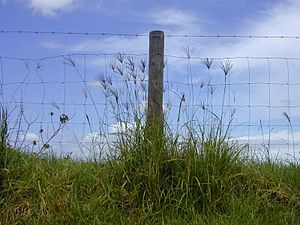Rhodes grass facts for kids
Quick facts for kids Rhodes grass |
|
|---|---|
 |
|
| Scientific classification | |
| Genus: |
Chloris (plant)
|
| Species: |
gayana
|
Chloris gayana is a type of grass commonly known as Rhodes grass. It originally comes from Africa. Today, you can find it growing naturally in many tropical and subtropical parts of the world.
This grass can grow in many different places. Farmers often grow it because it's good food for animals. It also helps cover the ground to stop erosion (when soil washes away). Rhodes grass can grow well even in soils that are a bit salty or alkaline.
Contents
What Rhodes Grass Looks Like
This grass is a perennial, meaning it grows back year after year. It can grow quite tall, from about half a meter to almost three meters high. It spreads out using special stems called stolons, which grow along the ground.
Rhodes grass forms clumps and can spread to cover large areas. Its flowers grow in finger-like clusters, up to 15 centimeters long. Each tiny flower part, called a spikelet, is only a few millimeters long. It holds one or two fertile flowers and up to four sterile ones.
How Rhodes Grass Grows
Rhodes grass grows mainly in the spring and summer. It doesn't need a lot of rain, only about 600–750 millimeters each year. This means it can survive in drier places.
It can grow in many different kinds of soil. It prefers soil that is not too acidic, with a pH level higher than 4.3. Also, Chloris gayana can handle a moderate amount of aluminum in the soil. Because it needs little rain, can grow in less acidic soils, and tolerates aluminum, it can be very helpful for farmers in warmer regions. It doesn't need a lot of care, so farmers can focus on other important tasks. It's also great for farmers who have land with poor soil.
Another good thing about Chloris gayana is how fast it grows. Its seeds sprout quickly, usually within 1 to 7 days, depending on the temperature. It often covers the ground completely within three months after planting. This quick growth is good for farmers who need to cover bare soil fast. It helps protect the soil from washing away.
How Rhodes Grass Handles Stress
A very important feature of Chloris gayana is its ability to handle dry weather, also known as drought tolerance. It can do this because its roots grow very deep, sometimes as far down as 4.25 meters, to find water. If farmers grow it for animal food, it can still produce well even during mild dry periods. Since this grass is good at handling drought, it helps farmers make sure their animals have food even when it's dry.
Rhodes grass is also very good at handling salty soil. Among different types of grasses, it is one of the most tolerant to salt. When soil is salty, plant growth is usually limited. But because Chloris gayana handles salt well, it's a great choice for farmers who have problems with salty soil.
Different Types of Rhodes Grass
There are different natural types, or "genetic varieties," of Chloris gayana. Some common ones are Katambora, Pioneer, and Callide.
"Katambora" is an important type that comes from Zimbabwe. It has been found to grow better in poorer soils than other types. Katambora is often used to make hay, which is dried grass for animals. This type is leafier, has finer stems, and produces more dry matter. Katambora is a "diploid" type of grass. Diploid types of Chloris gayana are generally good at handling frost, salt, and drought.
Another type of Chloris gayana is called "tetraploid." Tetraploid types flower later in the growing season. This means their quality as animal feed stays good for a longer time. Studies have also shown that tetraploid varieties of Chloris gayana have more nutrients. However, both tetraploid and diploid types have enough nutrients when they are young, before they flower. Knowing about these different types helps farmers choose the best one for their needs.
Practical Uses for Farmers
Chloris gayana can be very useful for farmers and organizations working on sustainable farming. Setting up pastures can be expensive and needs a lot of work. One way to help with this is to plant Chloris gayana together with food crops. This can save money for farmers who don't have many resources. For example, Chloris gayana can be planted under maize crops after the final weeding, without harming the maize yield. Growing animal feed crops alongside food crops can also improve the amount and quality of food for livestock. Planting Chloris gayana with food crops is a smart way for farmers to develop sustainable agriculture.
Farmers should also know some tips for harvesting Chloris gayana. The grass produces the most in its first two or three cuttings. Its nutritional value is highest when the grass is young, but it goes down as the grass gets older. Farmers should remember this to get the most benefit from the grass. When the weather isn't right for harvesting, Chloris gayana can be used for grazing animals directly. This helps farmers use the grass efficiently.
There are other practical benefits for farmers who grow Chloris gayana. It can help control weeds because it grows fast and can outcompete them. It also helps prevent topsoil erosion on sloped fields by holding the soil in place. Chloris gayana can also be planted with legumes like cowpea, stylo, and alfalfa. This mix helps improve the soil's nutrient levels. Managing weeds, preventing soil erosion, and improving soil are all important tasks for farmers. Chloris gayana can be a good solution for these challenges.
See also
 In Spanish: Chloris gayana para niños
In Spanish: Chloris gayana para niños

